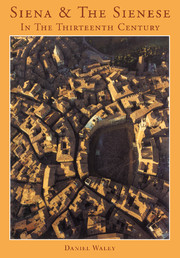Book contents
- Frontmatter
- Contents
- List of illustrations
- List of tables
- Preface
- Acknowledgements
- Glossary
- Abbreviations
- Chronology of principal political events and developments
- 1 Siena
- 1 Setting
- 2 People
- 3 Institutions
- 4 Oligarchy
- 5 Problems
- 6 Religion
- 7 Assumptions
- 8 Revenue
- 9 Expenditure
- 10 Continuity and change
- General Index
- Index of personal names
- Index of places
- Frontmatter
- Contents
- List of illustrations
- List of tables
- Preface
- Acknowledgements
- Glossary
- Abbreviations
- Chronology of principal political events and developments
- 1 Siena
- 1 Setting
- 2 People
- 3 Institutions
- 4 Oligarchy
- 5 Problems
- 6 Religion
- 7 Assumptions
- 8 Revenue
- 9 Expenditure
- 10 Continuity and change
- General Index
- Index of personal names
- Index of places
Summary
It is time to turn to the problems which presented most difficulty to the commune whose institutions and personnel have been discussed. They will be considered under three headings, first those relating to public order within the city itself, secondly those concerned with the maintenance of control over the contado, and thirdly those connected with external policy and the structure of alliances in the Italian peninsula as a whole.
INTERNAL DISORDER
The maintenance of order within the city presented difficulties to all the medieval communes. The laws against carrying arms show what sort of trouble was feared. Shooting with a bow or crossbow was forbidden on pain of a 200 1. fine and if this was not paid within a month the guilty person was to have his hand amputated. Throwing stones, particularly from a tower, was a serious offence, as was ‘starting a battle in the city’. Men tended to be on a short fuse, easily took offence and gave expression to their anger in physical violence, hence the laws referring to rixe and meschie (quarrels and fights, mêlées). Mercenaries, for example, were forbidden to enter the house of any magnate at a time when there was a rumore or meschia and there was a heavy penalty for summoning aid from outside the city at such a time.
‘Defensive arms’, i.e. armour, were permitted only to those holding special permits and the sole prima facie case for receiving such a permit was that the applicant had inimicitias capitales, ‘capital enmities’.
- Type
- Chapter
- Information
- Siena and the Sienese in the Thirteenth Century , pp. 97 - 126Publisher: Cambridge University PressPrint publication year: 1991

